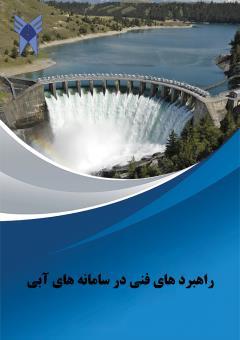مدیریت و دفع رواناب های سطحی با استفاده از سیستم اطلاعات جغرافیایی و روش فازی (نمونه موردی: بندر امام خمینی)
محورهای موضوعی : مدیریت منابع آبشهاب موسوی 1 , رامین ارفع نیا 2 , قاسم خسروی 3
1 - دانشکده مهندسی عمران، واحد لنجان، دانشگاه آزاد اسلامی، اصفهان، ایران
2 - گروه زمین شناسی، دانشکده علوم پایه، دانشگاه آزاد اسلامی، واحد اصفهان (خوراسگان)، اصفهان، ایران.
3 - دانشکده مهندسی عمران، واحد لنجان، دانشگاه آزاد اسلامی، اصفهان، ایران.
کلید واژه: آبگرفتگی, بندر امام خمینی, روش فازی, سیستم اطلاعات جغرافیایی, مدیریت رواناب,
چکیده مقاله :
هدف از احداث شبکههای جمعآوری آبهای سطحی فراهم آوردن امکان ایمنسازی شهر در مقابل حوادث غیرمترقبه (سیل) و بهبود بهداشت شهری و .... است. در طی بارندگیها سالهاي اخير در بندر امام خمینی به دلیل نبود کانالها و حتی جویهای انتقال روان آبهای سطحی بيشتر معابر و خیابانها دچار آبگرفتگی شدیدی شدند که خسارات عمدهای به زیرساختهای منطقه وارد شده است. هدف از این پژوهش مدیریت و دفع روانابها با استفاده از سیستم اطلاعات جغرافیایی در بندر امام خمینی بود. بدين منظور با استفاده از سيستم اطلاعات جغرافيايي در ابتدا لايههاي رقومي منطقه شامل ارتفاع، شيب، جهت شيب و شبكه زهكشي شهر تهيه گرديد. سپس با استفاده از روش منطق فازي فضاهاي داراي پتانسيل تجمع رواناب در منطقه مورد شناسايي قرار گرفتند. يافتههای تحقیق نشان دادند که تمركز اين فضاها در شرق، مركز ، شمال شرق و جنوب شرق منطقه ميباشد. با استفاده از تکنیک RiverTools و با توجه به نقشه شبکه زهکشی شهر، بهترین مسیرها برای احداث کانالهای پیشنهادی تهیه گردید. این کانالها شامل کانالهای فرعی، کانالهای اصلی درجه دو و سه بودند. کانال درجه یک کانال اصلی بود که جمع¬کننده¬ی آب¬های کانال¬های درجه دو و سه هم بود.
The purpose of building surface water collection networks is to enhance the resilience of cities against unexpected events such as floods and to improve overall urban health. Recent rainfalls in Bandar Imam Khomeini have exposed vulnerabilities, leading to severe flooding in roads and streets due to the absence of canals and surface drainage systems. The problem has caused significant damage to the infrastructure of the region. The research aims to implement a runoff management system using the Geographic Information System in Bandar Imam Khomeini. For this purpose, digital layers of the area, including elevation, slope, direction of slope, and drainage network of the city were prepared using the Geographic Information System. The fuzzy logic method was then employed to identify areas with the potential for runoff accumulation in the region. The research findings indicate that these areas are concentrated in the east, center, northeast, and southeast of the region. Then, using the RiverTools technique and according to the map of the city's drainage network, the best routes for constructing proposed canals were determined. These canals include sub-canals, second-order main canals, and third-order main canals. The first-order canal is the main conduit that collects the water of the second and third order canals.
Apel, (2018). Directive 2007/60/EC of the European Parliament and of the Council of 23 October 2007 on the Assessment and Management of Flood Risks. European Commission
Balistrocchi, M., & Grossi, G. (2020). Predicting the impact of climate change on urban drainage systems in northwestern Italy by a copula-based approach. Journal of Hydrology: Regional Studies, 28, 100670. https://doi.org/10.1016/j.ejrh.2020.100670
Barbosa, A. E., Fernandes, J. N., & David, L. M. (2012). Key issues for sustainable urban stormwater management. Water research, 46(20), 6787-6798. https://doi.org/10.1016/j.watres.2012.05.029
Berndtsson, R., Becker, P., Persson, A., Aspegren, H., Haghighatafshar, S., Jönsson, K., ... & Tussupova, K. (2019). Drivers of changing urban flood risk: A framework for action. Journal of environmental manage-ment, 240, 47-56. https://doi.org/10.1016/j.jenvman.2019.03.094
Engström, R., Howells, M., Mörtberg, U., & Destouni, G. (2018). Multi‐functionality of nature‐based and other urban sustainability solutions: New York City study. Land Degradation & Development, 29(10), 3653-3662. https://doi.org/10.1002/ldr.3113
Farzad Behtash, M. R., Keynejhad, M. A., Taghi Pirbabaei, M., & Asgary, A. (2013). Evaluation and analysis of dimensions and components of Tabriz metropolis resiliency. Honar-Ha-Ye-Ziba: Memary Va Shahrsazi, 18(3), 33-42. https://doi.org/10.22059/JFAUP.2013.51316. In Persian
Ghahroudi Tali, M., Majidi Heravi, A., & Abdoli, E. (2016). Vulnerability of urban flooding case study: Tehran, Darake to Kan. Journal of Geography and Environmental Hazards, 5(1), 21-36. https://doi.org/10.22067/GEO.V5I1.49976. In Persian
Mafi, E., Moradi, G., Hayati, S., & Khayampour, R. (2014). Management and Disposal of Urban Runoff Using Geographic Information System and River Tools Techniques (Case Study: District 1 of Ahwaz City). Journal of Geography and Regional Development, 12(1).
Nasri, M., Nasri, A., Shisheforosh (2016). Efficiency of surface water collection networks and investigation of the construction of runoff extraction reservoirs in Baharestan, 5th Conference on Rain Catchment Surface Systems, Gilan-Rasht, 1-20. In Persian
Rezaei, F., Behramand, A., Sheikh, V., Dasturani, MT, Tajbakhsh, SM. (2017). Determining the most important parameters affecting the amount of urban runoff using the SWMM model (case study: Mashhad city, region 9), Watershed Management, 12 (18), 135-151. https://doi.org/10.29252/jwmr.9.18.135. In Persian
Siari, M. (2016). GIS modeling of the basis of urban flood management in the study area: Shahr Khoi flood, master's thesis, supervisor Dr. Dawood Mokhtari, Dr. Khalil Walizadeh Kamran, University of Tabriz, Iran. In Persian

